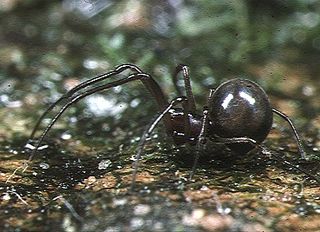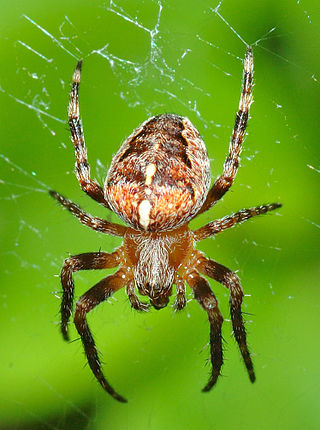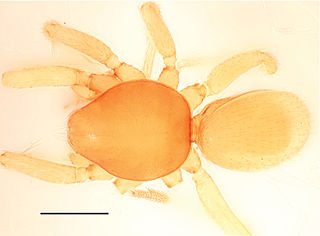
The Pholcidae are a family of araneomorph spiders. The family contains more than 1,800 individual species of pholcids, including those commonly known as cellar spider, daddy long-legs spider, carpenter spider, daddy long-legger, vibrating spider, gyrating spider, long daddy, and skull spider. The family, first described by Carl Ludwig Koch in 1850, is divided into 94 genera.

Oonopidae, also known as goblin spiders, is a family of spiders consisting of over 1,600 described species in about 113 genera worldwide, with total species diversity estimated at 2000 to 2500 species. The type genus of the family is OonopsKeyserling, 1835.

Ochyroceratidae is a six-eyed spider family, with 165 described species in ten genera. They are common inhabitants of caves and the tropical forest litter of South Africa, the Caribbean, Asia and South America. Considered an ecological counterpart of the Linyphiidae of the northern temperate zone, species are especially diverse in the Indo-Pacific region.

Telemidae, also known as long-legged cave spiders, is a family of small haplogyne spiders. Most are cave dwelling spiders with six eyes, though some do not have any eyes at all. There are about 104 described species in sixteen genera.

Anapidae is a family of rather small spiders with 232 described species in 58 genera. It includes the former family Micropholcommatidae as the subfamily Micropholcommatinae, and the former family Holarchaeidae. Most species are less than 2 millimetres (0.079 in) long.

Holarchaea is a genus of South Pacific araneomorph spiders in the family Anapidae, and was first described by Raymond Robert Forster in 1955. As of May 2019 it contains only two species, H. globosa and H. novaeseelandiae, but there may still be undescribed species in New Zealand.

Araneoidea is a taxon of araneomorph spiders, termed "araneoids", treated as a superfamily. As with many such groups, its circumscription has varied; in particular some families that had at one time moved to the Palpimanoidea have more recently been restored to Araneoidea. A 2014 treatment includes 18 families, with the araneoids making up about 26% of the total number of known spider species; a 2016 treatment includes essentially the same taxa, but now divided into 17 families.

Flexicrurum is a genus of spiders from China similar to the genera Althepus and Leclercera. Tong and Li originally placed the genus in Ochyroceratidae, but Tong later moved it to Psilodercidae. Males are generally smaller than 2 mm, but the size of females is unknown. The name is derived from Latin flex "curved", and crur "leg", referring to the inner turned palpal tibia of the male. As of 2019 three described species have been found in caves of Hainan Island.

Bannana is a genus of goblin spiders native to Xishuangbanna prefecture, Yunnan Province, China, where it lives in the leaf-litter of tropical rainforest. There are two known species: Bannana crassispina and B. parvula, both described in 2015. Individuals are pale yellow and unpatterned, and range from around 1.0 to 1.8 mm in body length, with females being slightly larger than males. The eyes are reduced or entirely absent. Known only from a nature reserve in Xishuangbanna, Bannana belongs to a group of Asian goblin spiders known as the "Dysderoides complex", that ranges from China to Pakistan and south to Indonesia.

Panjange is a genus of leaf-dwelling spiders in the family Pholcidae, widely distributed in the islands of Southeast Asia from Borneo and the Philippines to northern Australia. Panjange spiders exhibit some of the most extraordinary morphology among Pholcidae. Males of most species have eye stalks, sometimes with long pointed processes; males of some species have unusually elongated pedipalps, which in spiders function as copulatory organs; and females of some species have external portions of their genitalia strongly folded and extensible. The biological significance of these sexual modifications remain unclear.
Penangodyna is a monotypic genus of Southeast Asian cribellate araneomorph spiders in the family Dictynidae containing the single species, Penangodyna tibialis. It was first described by J. Wunderlich in 1995, and has only been found in Malaysia.
Vientianea is a monotypic genus of Laotian goblin spiders containing the single species, Vientianea peterjaegeri. It was first described by Y. F. Tong & S. Q. Li in 2013, and is only found in Laos.
Pinelema is a genus of Asian long-legged cave spiders that was first described by C. X. Wang & S. Q. Li in 2012.
Ixchela is a genus of cellar spiders that was first described by B. A. Huber in 2000.
Khorata is a genus of Asian cellar spiders that was first described by B. A. Huber in 2005.
Erigophantes is a monotypic genus of Indonesian dwarf spiders containing the single species, Erigophantes borneoensis. It was first described by J. Wunderlich in 1995, and has only been found on Borneo.
Tissahamia is a genus of southeast Asian cellar spiders named after Wanniyalaeto chief Uru Warige Tissahami. It was erected in 20180 for several species transferred from Pholcus after a molecular phylogenetic study of the Calapnita-Panjange clade of Pholcidae. They have long, thin abdomens that bend upward near the end. They also have six eyes, three on each of two eye stalks.
Cantikus is a genus of southeastern Asian cellar spiders first described by B. A. Huber, J. Eberle & D. Dimitrov in 2018.
Pribumia is a genus of southeast Asian cellar spiders erected in 2018 for several species transferred from Pholcus after a molecular phylogenetic study of the Calapnita-Panjange clade of Pholcidae. Six species previously in the minang group of Pholcus were transferred, but P. tahai is now in Apokayana. They have long, thin abdomens and six eyes, three on each of two eye stalks. The name is derived from the local term for Native Indonesians.
Shuqiang Li is a Chinese arachnologist and a professor at the Institute of Zoology of the Chinese Academy of Sciences. Li is best known for his work with spiders and has described hundreds of new species and many genera. He is Editor in Chief of the journal Zoological Systematics.









